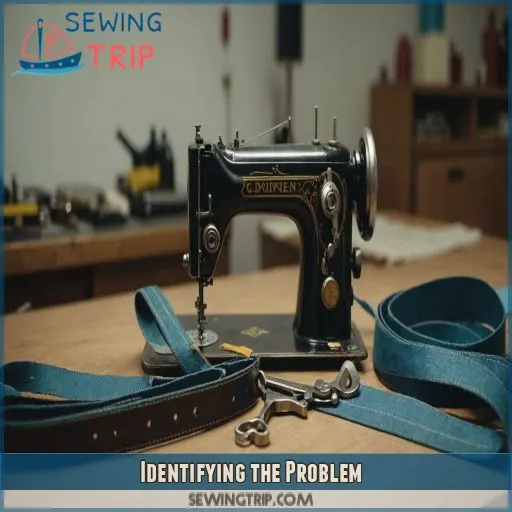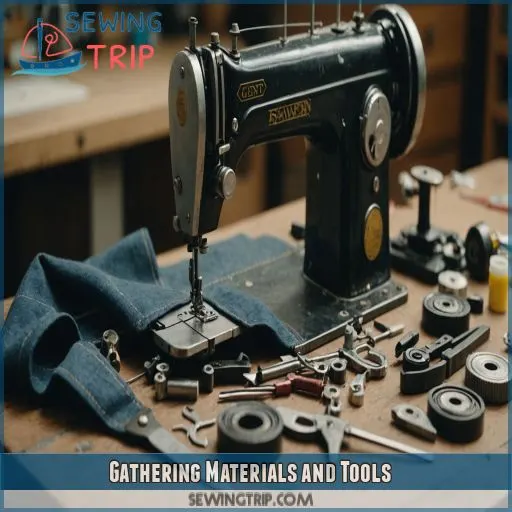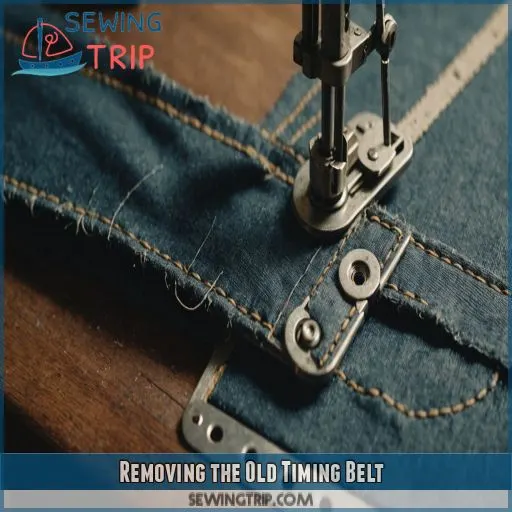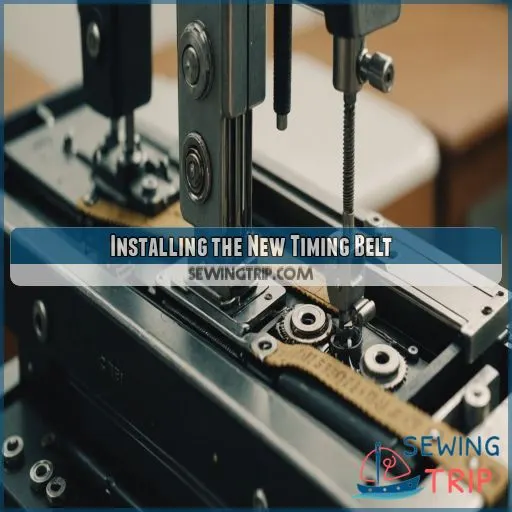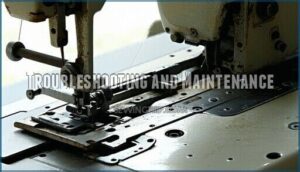This site is supported by our readers. We may earn a commission, at no cost to you, if you purchase through links.
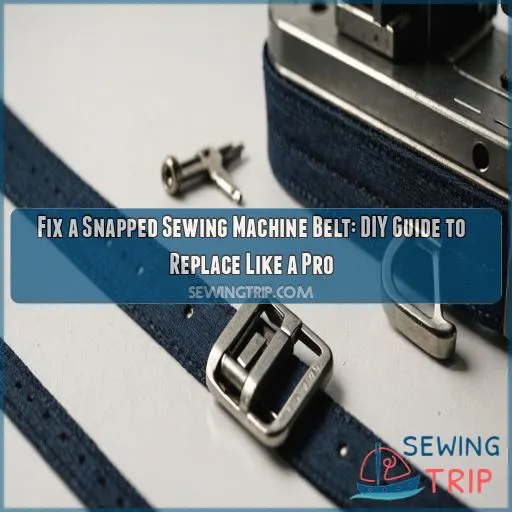 Is your sewing machine making strange noises or skipping stitches?
Is your sewing machine making strange noises or skipping stitches?
That could be a sign that your sewing machine belt needs replacing.
Don’t worry, it’s a pretty simple fix!
You can do it yourself with a few basic tools and a compatible replacement belt.
First, you’ll need to open up your machine and remove the old belt.
Then, carefully thread the new belt into place.
Don’t forget to adjust the tension for a smooth ride.
With a little patience and our step-by-step guide, you’ll have your trusty machine running smoothly in no time.
Table Of Contents
Key Takeaways
- You don’t need to be a sewing wizard to replace your machine’s belt. With some basic tools and a compatible replacement, you can tackle this DIY repair like a pro. Just remember to unplug your machine first – we’re aiming for a smooth stitch, not a shocking experience!
- Keep your eyes (and ears) peeled for signs of belt trouble. If your trusty machine starts making strange noises or skipping stitches, it might be crying out for a new belt. Don’t ignore these red flags, or you could end up with a costly repair on your hands.
- When installing the new belt, think of it like teaching your machine a new dance. Take your time aligning it properly with the pulleys, and adjust the tension just right. Too loose, and you’ll hit a sour note; too tight, and it might snap faster than your patience on a tricky project.
- Regular maintenance is key to keeping your machine humming along. Give that belt a gentle wipe-down every few months, and store your machine in a cool, dry spot when it’s not in use. With a little TLC, you’ll be stitching up a storm for years to come!
Identifying the Problem
You’re about to tackle a sewing machine belt repair, and we’re here to help you get it right. This guide will help you spot common issues with old machines, identify failing Timing Belt symptoms, and diagnose problems like a pro.
Common Issues With Old Sewing Machines
Old sewing machines can act up in a bunch of ways.
You might hear strange sewing machine noises, face needle problems, or deal with skipped stitches.
Maybe the bobbin tension’s off, or the foot pedal’s being finicky.
These issues are like a machine crying out for help.
Signs of a Failing Timing Belt
You’re sewing along, and suddenly, your machine starts acting up.
If you notice belt slippage, a noise increase, or stitching issues, it’s likely your timing belt is failing.
Uneven tension or visible belt wear are also red flags.
Don’t ignore these signs – a snapped belt can cause costly damage.
Catch the problem early and replace the belt to avoid headaches.
How to Diagnose a Timing Belt Problem
You can easily spot a timing belt issue by checking for common problems like belt tension, noise, wear, slippage, and damage.
A loose belt will cause a lot of noise and vibration.
Look for cracks, fraying, or missing teeth, which indicate it’s time for a new one.
A broken timing belt can also cause the sewing machine to jam or the needle to break, so it’s important to fix it ASAP!
Importance of Replacing the Timing Belt
So, your trusty sewing machine’s timing belt snapped. It’s a bummer, but it happens. Replacing it right away is super important, and here’s why:
- Sewing Machine Maintenance: A timely swap keeps your machine in tip-top shape.
- Belt Lifespan: Fresh belts last longer, reducing future sewing machine repair costs.
- Performance Boost: New belts sew smoother, faster, with fewer bobbles.
Gathering Materials and Tools
Now that you’ve diagnosed the problem, it’s time to gather the necessary tools and materials to replace your sewing machine’s timing belt. You’ll need a few basic tools, a replacement belt that matches your machine’s specifications, and some additional materials to make the repair go smoothly.
Required Tools for the Job
Now that you’ve diagnosed the problem, it’s time to gather your essential tools. You’ll need belt removal tools, like a screwdriver and pliers, to get the old belt off. Tensioning tools, such as a wrench, will help you adjust the new belt. Don’t forget lubrication tools and safety gear, like gloves, to keep you protected and your machine running smoothly.
Types of Timing Belts for Sewing Machines
Now that you’ve got your tools ready, let’s talk timing belts.
These little powerhouses come in various flavors.
You’ll encounter different belt materials like rubber or polyurethane, widths ranging from skinny to wide, and teeth patterns that’d make a shark jealous.
The length matters too – it’s not a one-size-fits-all game.
Don’t worry, though; we’ll help you find your perfect match without breaking a sweat.
Where to Buy Replacement Timing Belts
Now that you know your belt type, it’s time to snag a replacement!
You’ve got options galore: online retailers, local sewing shops, or straight from the brand’s website.
Just make sure to double-check compatibility with your machine model.
Pro tip: do a quick pricing comparison – you might score a sweet deal!
Additional Materials Needed for the Repair
You’ve got your new timing belt, but hold your horses! There are a few more items you’ll need to tackle this repair like a pro. Think of it as assembling your sewing superhero toolkit. Here’s what you should have on hand:
- Sewing machine oil (for smooth operation)
- Screwdriver set (to access those tricky spots)
- Needle plate (in case you need to remove it)
- New bobbin (always good to have a spare)
- Replacement needle (just in case)
Removing the Old Timing Belt
Now that you’ve got your tools ready, it’s time to tackle the old timing belt. This step might seem tricky, but don’t worry – we’ll walk you through the process of safely removing that worn-out belt without turning your sewing machine into a jigsaw puzzle.
Steps to Remove the Old Belt
Ready to tackle that old belt? Let’s get cracking!
First, unplug your machine – safety first, folks!
Now, pop off the cover plate like you’re opening a treasure chest. You’ll see the belt nestled in there, probably looking worse for wear.
Grab your trusty screwdriver and loosen any clamps or fasteners holding it in place. It’s like untying a stubborn shoelace, but you’ve got this!
How to Release the Belt Tension
Ready to tackle that stubborn belt tension? Here’s your game plan:
- Locate the release lever – it’s usually hiding near the handwheel.
- Gently push or pull the lever to loosen things up.
- If there’s no lever, look for adjustable screws or bolts.
- Use a tension gauge to make sure you’re not overdoing it.
Removing the Belt From the Pulleys
Now that you’ve released the tension, it’s time to free that old belt from its pulley prison.
Grab your trusty screwdriver and gently pry off any pulley covers.
With the path clear, carefully slide the belt off each pulley.
Take your time and be gentle; you’re not wrestling an octopus here!
Remember to note how the belt was threaded; it’ll be your roadmap for the new one.
Tips for Dealing With Stuck or Broken Belts
If you’re facing a stuck belt, don’t sweat it! A little heat from a hairdryer can work wonders, loosening that stubborn rubber.
For broken belts, you might need to channel your inner surgeon and remove it piece by piece.
And hey, if all else fails, a pro’s touch might save you a headache and potentially costly mistakes.
Installing the New Timing Belt
Now that you’ve removed the old timing belt, it’s time to install the new one. This step is really important for getting your sewing machine back up and running smoothly, so let’s walk through the process together to make sure you do it right.
Preparing the New Belt for Installation
Ready to give your sewing machine a new lease on life? Before you jump in, let’s prep that shiny new belt:
- Check the belt type – it’s gotta match your machine like peanut butter matches jelly
- Give it a once-over with a lint-free cloth to nix any manufacturing residue
- Flex the belt gently to wake it up from its packaging slumber
Aligning the Belt With the Pulleys
Ready to tackle belt alignment? It’s like teaching your sewing machine to dance! First, check those pulleys – they should be smooth as a baby’s bottom. Now, carefully loop your new belt around them, making sure it’s seated just right. Remember, a well-aligned belt is the secret sauce to smooth stitching. Take your time here; it’s worth getting it spot-on!
Adjusting the Belt Tension
With the belt in place, it’s time to get that tension just right.
Think of it like tuning a guitar string: too loose, and you’ll hit a sour note; too tight, and it might snap.
Use a belt tension gauge to find that sweet spot.
It’s the secret sauce for smooth sewing!
Testing the New Belt
You’ve done the hard part, now it’s time to put your handiwork to the test! Fire up your machine and run a quick sewing test. Keep your ears peeled and your eyes sharp. Here’s what to look out for:
- Smooth, quiet hum of the motor
- Even, consistent stitches
- No skipped or bunched threads
- Fabric feeding smoothly
- Machine running without hiccups
If everything checks out, pat yourself on the back – you’ve just given your trusty sewing companion a new lease on life!
Troubleshooting and Maintenance
You’ve replaced your sewing machine’s timing belt, but your work isn’t quite done yet. Now it’s time to troubleshoot any lingering issues, fine-tune the belt’s performance, and learn how to keep it in tip-top shape for years to come.
Common Issues After Replacing the Belt
| Issue | Possible Cause |
|---|---|
| Loud noise | Belt too tight |
| Skipped stitches | Incorrect needle timing |
| Thread bunching | Improper thread tension |
| Machine won’t run | Belt slipping or misaligned |
How to Adjust the Belt for Optimal Performance
After installing your new timing belt, you’ll want to fine-tune it for peak performance. Here’s how to adjust your belt like a pro:
- Check belt tension – not too tight, not too loose
- Make sure the belt is properly aligned on the pulleys
- Listen for unusual noises during operation
- Watch for signs of slippage or wear
- Test different stitch types to gauge performance
Tips for Maintaining the Timing Belt
Now that your belt’s purring like a kitten, let’s keep it that way.
Give it a gentle wipe-down every few months to nix any dust or lint buildup.
A dab of sewing machine oil on the pulleys keeps things running smooth.
When you’re not stitching up a storm, store your machine in a cool, dry spot.
When to Replace the Timing Belt Again
You’ve mastered the art of belt replacement, but when should you do it again? Don’t wait for a snap to catch you off guard! Keep an eye out for these telltale signs:
- Your machine starts skipping stitches like a hyperactive kid
- The belt looks frayed or worn, like your favorite old jeans
- You hear strange noises (and it’s not your cat in the sewing room)
- The belt feels loose or slips when you’re sewing
- It’s been 3-5 years since the last replacement
Frequently Asked Questions (FAQs)
How often should I replace my sewing machine belt?
You’ll want to replace your sewing machine belt every 3-5 years, or sooner if you notice signs of wear. Listen for unusual noises and watch for slipping stitches – your machine’s telling you it’s time for a tune-up!
Can I use a generic belt for my specific model?
You can use a generic belt, but it’s risky. Your machine’s specific model might need a particular size or type. It’s like putting the wrong shoes on – they might fit, but you won’t run your best race!
What causes a sewing machine belt to wear out?
You might think belts last forever, but they don’t! Your sewing machine belt wears out from constant use, heat, and tension. Over time, it stretches, cracks, or frays. Regular maintenance can extend its life, but eventual replacement‘s inevitable.
Is it possible to repair a damaged belt?
You can’t repair a damaged sewing machine belt, but don’t sweat it! It’s a common issue. Your best bet is to replace it entirely. It’s a quick fix that’ll have your machine humming again in no time.
How do I adjust belt tension after replacement?
You’ve just replaced your sewing machine belt, feeling like a DIY champion. Now, let’s fine-tune it! Adjust the tension by turning the handwheel. It should turn smoothly without slipping. If it’s too tight, loosen slightly; if too loose, tighten a bit.
Conclusion
Replacing a sewing machine belt isn’t as scary as it might seem.
Don’t let a snapped belt derail your sewing projects.
With this tutorial, you’re now equipped to tackle this common repair like a pro.
By following our step-by-step guide, you’ll be back to stitching in no time.

